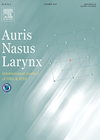
Journal Reviews archive for September 2019
Outcomes of temporal bone-resurfacing for pulsatile tinnitus associated with vascular wall anomalies
This month’s Ed’s choice is an interesting systematic review into the management of pulsatile tinnitus. There are impressive results from resurfacing of symptomatic anatomical abnormalities of the temporal bone and I suspect that referrals for further imaging and otology clinic...
Outpatient solution for a Patulous tube?
Definitive diagnosis and management of Patulous Eustachian tube (PET) is unsatisfactory. Several different treatment methods are currently used for PET which itself indicates no satisfactory solution. The objective of this study was to compare the outcomes of two different treatment...
Daflon – a new way to treat idiopathic epistaxis
Epistaxis is a common ENT emergency and most cases are idiopathic. Flavonoids are natural substances with variable phenolic structures that are found in fruit and vegetables and take effect on blood vessels. Daflon is proposed to control epistaxis by “improving...
Work and the risk and carcinoma of the larynx
This is a census on the national cancer registry in France to detect professions at a higher risk of squamous cell carcinoma of the larynx. During the period 2001-2016 there were 244 registered cases of cancer of the larynx. Amongst...
Lingual tonsils and obstrucive sleep apnoea syndrome (OSAS)
Obstructive sleep apnoea can be due to narrowing of the retrolingual space by hypertrophic lingual tonsils. The authors studied 11 patients (five males and six females with a mean age of 44.3 years and a mean BMI of 28.6). All...
Which graft is better for type 1 tympanoplasty in elderly patients?
Type 1 tympanoplasty is a procedure performed to repair tympanic membrane perforations, primarily to reduce otorrhoea. This may subsequently lead to improvement of hearing. The common graft materials used are temporalis fascia and cartilage from tragus or concha. The authors...
Which cross-over frequency is best for electro-acoustic stimulation?
Advances in technology and improved soft surgical techniques have led to individuals with better hearing thresholds, especially at the low frequencies, becoming candidates for cochlear implants (CI). Surgeons are more confident that residual hearing can be preserved thus making those...
Gastro-oesophageal reflux and cricopharyngeal dysfunction – how do they link?
It has been hypothesised that cricopharyngeal muscle hypertrophy develops as a response to chronic gastro-oesophageal reflux disease. The cricopharyngeus muscle is an important component and contributor to the upper oesophageal sphincter that creates a barrier between the pharynx and oesophagus....
Narrow band imaging improves diagnosis of malignant laryngeal lesions
The manufacturers of narrow band imaging (NBI) claim better visualisation of mucosal abnormalities when compared with simple white light. The primary aim of the study was to compare the diagnostic accuracy of NBI and white light to diagnose malignant laryngeal...
Cochlear implants and speech perception
Cochlear implants can be an effective treatment for specific hearing losses. They may often be the only way to restore hearing for profoundly deaf people. Therefore, it is very important to understand all processes that may influence effective fitting of...
Macrolinguistic assessment in early Alzheimer’s disease
Deficits in language production like word finding difficulty, and lexical-sematic impairment have been documented early in the course of Alzheimer’s disease (AD). According to the authors, the current language assessment methods used in AD patients do not account for macrolinguistic...
Is bone scanning still of value?
This is an article from Australia of 109 patients, 83 of which had CT, 72 MRI and the presence of bone invasion on imaging was compared with the histopathology. Bone invasion was present in 44 of 109 resection specimens. Bone...

















